How To Make Money With Algae Microfarms
In Algae Biorefineries and and Micro Farms, (Algae Microfarm, for short) we dive deep into the world of algae, it's products, it's co products, and more specifically how YOU can make money from the coming "Algae Revolution." Making algae biofuels is only scratching the surface of this remarkable organism.
If you're serious about making money with algae, then Algae Microfarms is for you.
Perhaps no other opportunity this century has offered the potential of algae-based products. Algae is a basic building block of life itself, therefore, many other products we know today spring from it. In this one-of-a-kind book, we explore the many products, and the many pathways to producing those products.
No other book on the market explores these issues, or details the methods and techniques involved in bringing this "super material" to market.
Once again, David Sieg has composed and excellent guide, whether for fuel, food, animal feed, fertilizer, or even cosmetics. He covers the range from home use to large-scale commercial systems, from a distributed and survival perspective; yet practical enough for modern implementation -- a hallmark of true sustainable principles.
We'll be consulting this guide in the Safe Haven Villages (.org) intention community I'm involved with. In a day when central authority is growing more tenuous, the ability to do things in a distributed model is growing increasingly vital; and it just makes more sense from a seventh-generation sustainability point of view, while still being profitable in today's economy.
In fact you might consider this as a career that will not only survive the downturn, but help you and many others make it through the worst of times to come; all while pioneering a future industry.
Pure Energy Systems Network
Why should you invest in this report?
- Written for the layman, or non-technical person.
- The report highlights different, inexpensive methods of building algae microfarms having a focus on bio fuels and bio-energy.
- It provides extensive details on every aspect of building algae microfarms
- It presents numerous examples of what the pioneers in the field are doing in the algae energy domain.
- It showcases methods of building low-cost algae biorefineries.
- It highlights ways to build commercial algae microfarms economically.
- It provides current and future research areas in algae co products
- It provides extensive knowledge on commercial algae microfarms...what works, and what doesn't.
- It provides commercial research, enabling students, teachers, and researchers to quickly and easily get up to speed.
- It provides details for alternative algae products not just biodiesel - from algae.
Hi David,
| Yes it does make sense and is very clear. I am a Professor of Chemical and Biological Engineering specialized in chemical and biochemical reactors, I have over 400 papers, 4 patents and 4 books...I like your simple books to the ordinary person |
New Mexico Tech. University,
Everything You Always Wanted To Know About Algae Microfarms (But Didn't Know Where To Ask...)

Why Algae Microfarms now?

The World is Ready for a Solution
Agricultural Land Availability Issues
Global Warming Issues
Energy Security
Potential Depletion of Fisheries
Why is Now the Time to Pursue Algae Biorefinery?
Consumer Interest:
Changes in Nature
Changes in Technology
Algae’s Competitive Advantages

Chapter Two: The Basics of Micro Algae Farming and Biorefineries
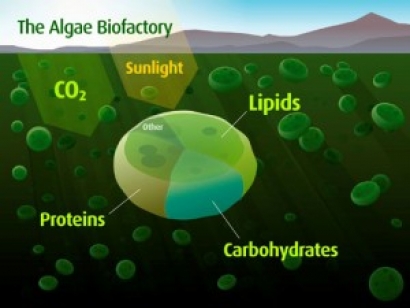
A SWOT Analysis of Biorefineries
What is an algae microfarm?
Understanding the Biorefinery concept.
Algae Microfarms
An Algae Microfarm Case Study
A Biofuels Case Study
A Developing World Case Study
A Village Scale Case Study
A Government Scale Case study


Chapter Three: Potential Challenges With Micro Algae Farms
Algae Biofuels Legal Aspects
Possible Issues with Independent Contractors.
When the technology belongs to you and you wish to sell or license it’s use.
Site Security
Environmental Issues
David really knows what he’s talking about when it comes to biodiesel. And his new book “Building Open Ponds” shows it... it’s 277 pages jam packed with tons of great information from growing algae in an old bathtub to large scale algae farms. Great details and pictures to make it as easy as pie even for the novice. David really goes the whole nine yards when he writes a book!
Author, www.electricitybook.com

How To Finance Your Project

Some different types of financing
Kinds of Investors
Locating Equity Resources
Debt Funding
Loan Guarantees
Tax Incentives as well as other Tax Considerations
Government Grants and Incentives
Other Programs Available
Algae Microfarm Grants

Chapter Five: Planning

Types of algae microfarm
Designing your Bio-refinery
Building a Bio-refinery
Site requirements for algal biorefinery
Co Location with Advantageous Partners
Integration with Water Treatment Facilities
Wastewater Treatment and Recycling Uses
Personnel Considerations
Necessary Algal Characteristics
Strain selection
Commercial Culture Labs and Collections
Natural Habitats
Disadvantages to Co-Location with Stationary Industrial CO2 Source
Algae production Costs and Uncertainties
Realistic Costs Associated with Biorefineries
Co location with CO2 emitting Sources
Conclusions

Chapter Six: Algae Products and Co-Products

Courtesy of Wiki Commons
Commercial Products from Microalgae and Cyanobacteria Algae Based Biofuel
Biodiesel
Bioethanol
Biogas or Biomethane
Biobuthanol
Biohydrogen
Bioelectricity Gasification Tar
Algae Coal
Challenges to Algae to Biofuel Commercialization
Feed stock Challenges
Conversion Challenges
Fuel Conversion:
Co-Products:

Algae Bio-Concrete
Infrastructure Challenges
Distribution and Utilization
Resources and Siting.
Algae-based products for human consumption
Algae as a Staple food
Algae and the Food Industry
Health foods and pharmaceuticals
Aquaculture:
Animal Feed Additive:
Nutraceuticals
Astaxanthin
Omega-3 Oils
Anti-Oxidants
Pharmaceutical Uses of Algae
Cosmetics
Algae Fertilizers
Other Specialty Products
Paper
Bio Concrete
Bio Plastics
Fine Chemicals
Low-value Coproducts
Commercial Products from Macroalgae.
Other macroalgal foods.
CO2 mitigation
Carbon sequestration
Carbon trading
Conclusions

Chapter Seven: Co-Product Recovery

Potential Options for the Recovery of Co-products
Maximum Energy Recovery from the Lipid-Extracted Biomass,
Recovery of Protein for Use in Food and Feed
Technically feasible algal bioenergy co-production concepts
Economic viability of bioenergy co-production from algae
References

Chapter Eight: Algae Microfarm Production

Introduction:
Proof of Concept Introduction
Pilot Scale Introduction:
Production Scale Introduction:
Proof of Concept
Obtaining the algae strain you’re interested in.
Native Algae
Commercial Algae Strains
Maximizing Growth
Small scale harvesting
Processing
Pilot Scale
Open ponds
Closed Ponds
Photobioreactors (PBR) and Bioreactors
Production Scale
Open Ponds
Water Resources
Carbonation
Mixing Systems
Other Factors
Closed Ponds.
Photobioreactors
Harvesting
Screening
Filtration
Filtration and Screening Devices
Pressure Filters
Vacuum Filters
Rotary vacuum filter
Micro Strainers
Magnetic Separation
Centrifugation
Tubular centrifuge
Imperforate basket centrifuge
Flocculation or sedimentation
Flotation
Flocculation and Dissolved Air Flotation
Electroflotation
Other Harvesting Techniques
Drying
Rotary Dryers
Flash Drying
Spray Drying
Sun Drying
Summary of harvesting methods
Oil Extraction Technologies
Mechanical Disruption (i.e., Cell Rupture)
Mechanical Expulsion
Solvent Extraction
Supercritical Fluid Extraction
Osmotic Shock
Sonication and/or Ultrasound
Organic and/or Chemical Co-solvent Mixtures
Subcritical Water Extraction
Challenges Associated with Production Scale
Avoiding contamination
Adding Co2
Constant inoculation
Stressing algae
The problem with yield extrapolation
Hydrocracking algae biofuels
GMO algae
The Ideal Algae for Biofuels

Chapter 9: Algae microfarm Resources, Equipment and Vendors:

Buying the algae strain you’re interested in.
In North America
Mexico
Europe
Czech Republic
France
Germany
Australia
Japan
Algae Biofuels Contractors and Equipment Vendors

Open Ponds
Pond Liners and pond equipment
Photobioreactors
Acrylic tubing for bioreactors
Plastic Tanks for PBRS
Plastic (PVC) pipe fittings
LED Lighting
Steel mesh filter cloth
Oil presses and extruders
References

Chapter 10: Marketing Algae Products
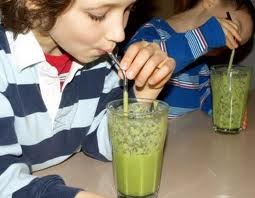
Marketing Algae Based Products.
Marketing to Corporations: Marketing to Consumers
Marketing Challenges of Algae Directly to Consumers
Algae, Junk food, and Beer
Algae based Junk Food (except it isn’t)
Algae based beer
Algae Cosmetics
Create your own product
Bringing a Food Product to Market
Developing and Marketing an Algae Cosmetic Product

Chapter 11: Case Studies

Aurora Biofuels
Phycal, Inc.
Amyris Biofuels
Sapphire Energy
Solazyme, Inc.
Seambiotic
Algae-Tec Limited
Algae Floating Systems, Inc.
Alpha To Omega Holdings
Algenol Biofuels Inc.
Cereplast
Solix BioSystems, Inc
Synthetic Genomics Inc
Dao Energy, LLC
Kai Bioenerg
Live Fuels, Inc.
Pond Biofuels, Inc.
Bioprocess Algae, LLC
Algae Microfarms: What You’ll Get
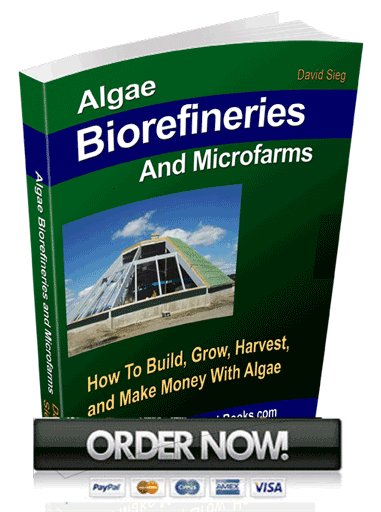
Over 400 pages, full color paperback for your library
11 chapters of jam-packed, no fluff, no BS info
Full Color
Perfect bound

10 valuable bonus reports Instant download of bonus material.
1164 Pages of bonus material in .pdf format

One of the most comprehensive treatments of all aspects of a commercial algae microfarms available anywhere, including equipment lists and cost breakdowns.
About the Author
In 1995, as one of the first Americans to reenter Vietnam after diplomatic relations were restored, David Sieg, while teaching at a university, started making biofuels, then later, algae biodiesel.
With the oil embargo still in effect, Mr. Sieg used his knowledge of biofuels to run the university generators to get lights and air conditioning. Seeing how many people could benefit, he later opened a algae bio fuels consulting business in Vietnam, and Thailand.
In 2008, knowing the secretive nature of the algae biodiesel industry and the lack of real world info, he created making-biodiesel-books.com to share his knowledge. Here you'll find real world applications, "How-To" knowledge you won't find anywhere else.
Other sites might tell you WHAT to do, but none of them tell you HOW to do it. We do.


Bonus Section, Time to Over Deliver!
Bonus Material
1164 pages of in-depth Algae Microfarms Operations and Micro Farm Detail You’ve Come To Expect

Algae Based Biofuels: Applications and Co Products (117 pages)
A comprehensive paper by the Environment and Natural Resource Group exploring the different applications and co products available using micro algae.

Algae Biofuels Roadmap: (140 pages)
One of the most valuable reports published since the Aquatic Species Program and the detailed background of many of the concepts presented in the main book itself. This is a MUST-HAVE report that belongs on any serious algaepreneurs bookshelf.
A comprehensive paper by the Environment and Natural Resource Group exploring the different applications and co products available using micro algae.
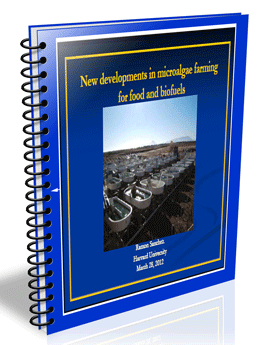
New Developments in Micro Algae Farming for Food and Biofuels (44 pages)
A Harvard University document outlining the advantages and disadvantages which algae farmers will be faced with currently as well as in the future.
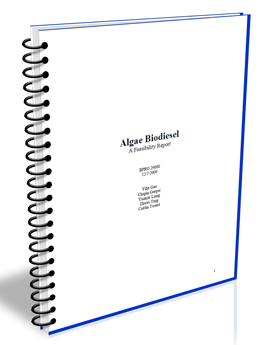
Algae Biodiesel: A Feasibility Report (43 pages)
An in-depth report covering the feasibility, as well as the pitfalls of algae biodiesel production.

Design and Analysis of “‘ Microalgal Open Pond Systems for the Purpose of Producing Fuels A Subcontractors Report (231 pages)
In-depth and to the point, this report covers it all.

A Realistic Technology and Engineering Assessment of Algae Biofuel production (178 pages
In-depth and detailed, this report lays bear the bones of all aspects of engineering an algae biofuels facility. Including various options and techniques available.
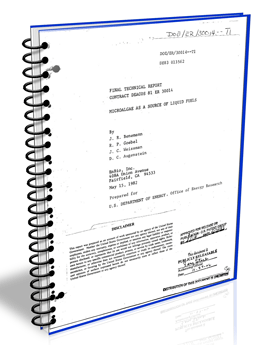
Microalgae as a Source of Liquid Biofuels (229 pages)
By John Benemann, the “grandfather” of algae biofuels, and one of the founding members of NREL’s Aquatic Species Program. This report prepared for Enbio, Inc, is one of the most detailed, and through reports found anywhere

Renewable Diesel from Algal Lipids: An Integrated Baseline for Cost, Emissions, and Resource Potential (89 pages)
From the NREL, this report was commissioned by the Dept. of Energy and provides a realistic baseline of costs associated with a micro algae project.

Genetic Engineering of Algae for Biofuel Production (44 pages)
An extremely hard to find report. Many people have asked for this and now it’s yours.

Production of Gasoline and Diesel from algae Biomass via Fast Pyrolysis, Hydrotreating and Hydrocracking (76 pages)
Another hard to find report outlining what it takes to create advanced fuels such as gasoline and jet fuels.
Everything is 100% Take-It-To-The-Bank Guaranteed

All the best to you and your family,
David Sieg
www.making-biodiesel-books.com
PS...In a world-wide climate of massive unemployment, “down-sizing,” “right-sizing,” and outsourcing, few opportunities exist today to create a lasting income that can serve your family for generations, help the global village, while at the same time, contribute to saving the environment. The Algae Revolution presents just such an opportunity. Can you afford to pass this opportunity up?
Disclaimer: All testimonials and comments are unpaid. These comments reflect the viewpoints and/or experiences of a people named and you may, or may not have similar results.
* Every effort has been made to accurately represent this product and its potential. Please remember that each individual’s success depends on his or her background, dedication, desire and motivation. As with any endeavor, there is no certain guarantee of success. Please observe all laws in your local area.
Legal Information Disclaimer | Terms Of Service |Refund Policy| Privacy Notice


